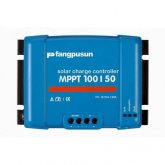It seemed like this would be the hardest part of the build to run the wire going to and from the panel.
You want the inverter/charger as close as possible to the batteries.
The batteries like a nice human friendly climate so its good to have them in the living space.
Its good to have the batteries close to the dc distribution panel but not nearly as important and having the inverter/charger close to the batteries.
Where are you planning on putting the core system?
Also how far will it be from the core system to the ac/dc distribution panel?
I am curious to know what the drawbacks are with the Renogy products, I've only really seen reviews of their mppt controller that were positive, not sure about their inverters.
IMO Renogy products are designed to sell.
The website is approachable and it appears to be one stop shopping.
I bet lots of people buy them for their first system.
I doubt many buy from them for their second system.
Also IMO Renogy support kinda sucks.
They make this stuff appear to be easy.
Solar is easier than it used to be, but its not really
that easy yet.
What's your thoughts on the Growatt units? So far the online reviews seem positive.
I would pick them over Renogy.
My Trailer has electric stabilizers, not jacks. I don't think they draw much power at all. That being said, the trailer technician says that everything on the trailer requires 12V, even the AC needs 12V to work on 120V. Is a buck converter sufficient or am I asking for trouble by using a 24 V system?
A
quality buck converter can do a lot.
A
quality buck converter plus a small agm battery can handle even more.
If you do go 24 volt put the buck converter as close as possible to the dc distribution panel.
Amperage and voltage drop are both lessened at 24 volts vs 12 volts.
I did try the audit tool although I have partial information, my trailer is on order and I won't have it for about a month. I am trying to get all the components ordered so I can hook it all up right away.
Its a "bad idea"TM to buy stuff until you have a plan.
A plan starts with an energy audit.
As far as I am concerned, I'd rather overkill it and not worry about my usage.
You can't afford a Victron inverter/charger but you want to "overkill" it.
That is hard to reconcile.
Looking online a 1000W buck converter is only about $85.
I bet you are referring to those cheap silver ones on amazon or ebay or similar.
Check the negative reviews.
That is why I stressed the word quality above.
Is there really a concern to be had with my 12V system not running properly with a buck converter?
Yes, as always the devil is in the details.
Alternatively, I could also use a cheap standard 12V lead acid on the front of the trailer that hooks up to the 12V system. Since the trailer is wired this way, this would be pretty simple. I am assuming that the battery would stay charged as the main panel would think that I am constantly on shore power and would automatically charge that battery.... Or is that a bad idea?
Could be a plan.



